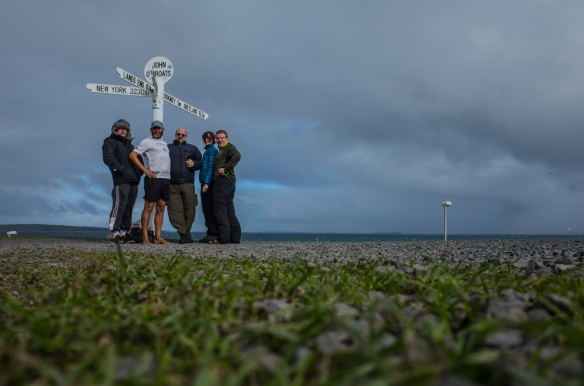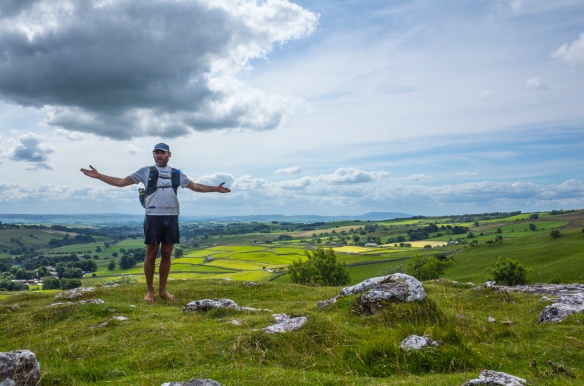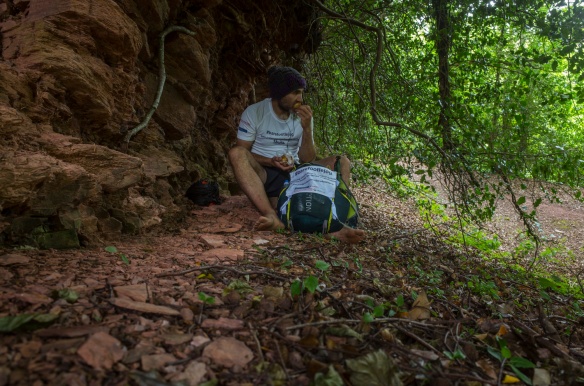Written by Aleks Kashefi - https://pursuingthevoid.wordpress.com

I finished at 10pm on the 2nd of September after a 53 mile day in 10 hours of running. This was the day after, having had a nice evening of celebrating with the traditional Scottish beverage. There’s nothing like making fun of yourself with a proper wolly pose ;)
Sean Conway, having completed his JogLe posted an article called the 4 elements of trail running. At the time, I was in the process of putting the final pieces of my LeJog in place, so I read with interest and even added an additional element.
Travelling for 38 days, carrying what you need to survive tends to provide you with lots of time to ponder ephemeral ideas like the nature of endurance or how we escape from that dark place we sometimes find ourselves as ultra runners. The whole elements of trail running seemed to stick in my head and it seemed to me that there are actually 3 elements to focus on. The 4 Sean Conway mentions are actually breakdowns of these 3 elements and having complete LeJog, barefooted and unsupported in 38 days, I think I can put my thoughts down (38 days is a long time to think!).
The first element, although they are all of equal importance is mechanics. I’m referring to the understanding of how you move as a person and developing the efficiency of this movement. I felt I was reasonably efficient when I ran or walked, but on the 5th day I found I was moving far better than day one. Maybe it was getting used to the 8kg pack or even the breakfast I ate, but regardless, running along the Devon section of the South West Coast path felt more fluid that running ever had. Later I was using what I knew about physiology (research in book like Anatomy for Runners and various podcasts and websites) and I would then treat the problem and alter my movement as consciously as I could to prevent the problem. My hips would hurt near the end of the trip and so I dealt with them by working on my quads that were causing the problem. The was one problem early on that could have ended the barefoot LeJog adventure after just 5 days. I was thrown off my feet by the gales of day 2 and had a lovely bruised lump on the top of my left foot. We compensate for injury, no matter how small and alter our mechanics, and mine caused severe tendentious at the join between my Achilles and my Soleous muscle.
This was hard to deal with and then leads to the second element, mentality. We train our bodies when we take on long distance running (well, any length of running or exercise) but how often do we train our brains? Day 6 was a difficult day. I had nothing to do, I could barely walk around and the time seemed to be used by my brain to think about failure. I realised a few days after that I wasn’t looking into that dark place but I had fallen in. The people who had virtually joined in, donated money and spoken to me at races before LeJog became a whole host of people I was going to let down. Then the phone buzzed and a friend sent me a message that threw my own words into my face…
“You either do something or you don’t. There’s no trying to do something”
I’d like to thank Master Yoda for that pearl of wisdom, but it had a massive impact on me. I genuinely believed those words when I spoke them and they seemed to trigger some kind of flow state. The rest of the run was rescheduled so that I had several weeks of short days and I set my mind to getting as far as I could. I think this is the part of our mentality as ultra runners that we need to celebrate and keep building. We can enter these flow states and become problem solving machines, but it seems to take utter immersion in what we’re doing and slight changes to our environment to trigger them. The other part of the mentality that is equally as important is acknowledging the suck! We know when things are bad, but we don’t always acknowledge them. I reached a point near the end of the trip where I would just admit I was tired, admit I needed to stop and once I did this, solving the problem seemed to be easier, whether it was related to physical or mental tiredness. Mental tiredness tended to end in a quick snooze and the physical tiredness was in some cases completely removed by knowing what to eat.

Above Malham Cove. One of the best climbs of the trip with some awesome limestone slabs to bounce around on.
Now comes the third element which is metabolism. By this I’m not just referring to what we eat, but how our bodies utilises water and the food we put in. After 2 weeks, I was barely eating anything. I would mix a bottle of tailwind up (2 scoops in 600ml) and this would last me for half a days worth of moving, followed by a refill and then an evening meal. Admittedly I was staying aerobic for most of the time, but even on the occasions where the trail was tremendous and it would be a sin not to unleash for just a few miles, I didn’t seem to need the extra fuel that we are told we need. I would go into shops after 20-30 miles and what I purchased was specific. I even left a fair few shops with no extra food and just water, even though I knew the day after would be a long one without any form of food stops. Now this is all diet based, but there is the side of metabolism that relates to what fuels we burn whilst moving and it really did seem to boil down to fat as fuel and glucose as a minor top up. I must have been doing something right though since I lost 10lbs over all, which was 4% of body fat with a 2% muscle gain. I was hoping to at least lose enough to get that coveted six pack!

Two days after I restarted (day 9) I was lucky enough to be given a bag of left over roast potatoes and a nice lunch they made too.
Now I’ve been really brief with these elements, since I have lots of thoughts on each one, in particular the mechanics and mentality elements. They are what made the trip as successful and for the majority of time a joy to do.
What was or wasn’t on my feet aside, once I got my head around the mentality and mechanics elements the metabolism seemed to be second nature. If something hurt, I would hunt for the source of that pain, whether it was poor movement, tight muscles or the distribution of weight in my pack. Aches and pains that I was getting seemed to go, new ones developed until I found their source and they would be banished too.
It’s time to round this off as the first part. These 3 elements deserve a little more time, so I’ll be working on my thoughts some more and posting about them as distinct ideas, but as far as the LeJog write up goes, this is part 1 of a possible 3.
Hope you found something useful or interesting in this post.

